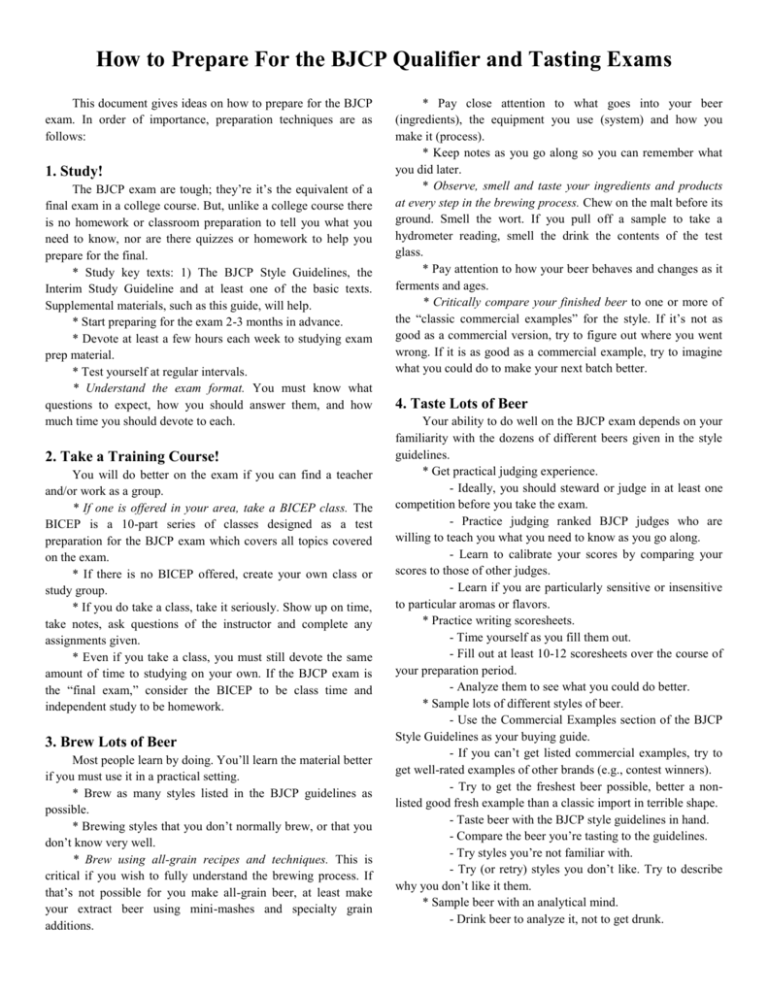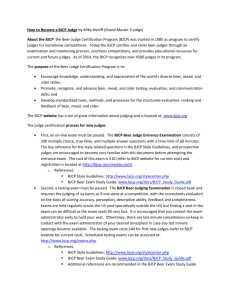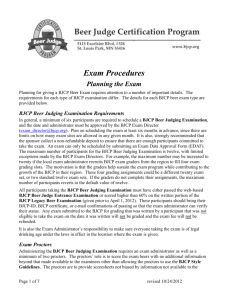How to Prepare for the BJCP Qualifier and Tasting Exams
advertisement

How to Prepare For the BJCP Qualifier and Tasting Exams This document gives ideas on how to prepare for the BJCP exam. In order of importance, preparation techniques are as follows: 1. Study! The BJCP exam are tough; they’re it’s the equivalent of a final exam in a college course. But, unlike a college course there is no homework or classroom preparation to tell you what you need to know, nor are there quizzes or homework to help you prepare for the final. * Study key texts: 1) The BJCP Style Guidelines, the Interim Study Guideline and at least one of the basic texts. Supplemental materials, such as this guide, will help. * Start preparing for the exam 2-3 months in advance. * Devote at least a few hours each week to studying exam prep material. * Test yourself at regular intervals. * Understand the exam format. You must know what questions to expect, how you should answer them, and how much time you should devote to each. 2. Take a Training Course! You will do better on the exam if you can find a teacher and/or work as a group. * If one is offered in your area, take a BICEP class. The BICEP is a 10-part series of classes designed as a test preparation for the BJCP exam which covers all topics covered on the exam. * If there is no BICEP offered, create your own class or study group. * If you do take a class, take it seriously. Show up on time, take notes, ask questions of the instructor and complete any assignments given. * Even if you take a class, you must still devote the same amount of time to studying on your own. If the BJCP exam is the “final exam,” consider the BICEP to be class time and independent study to be homework. 3. Brew Lots of Beer Most people learn by doing. You’ll learn the material better if you must use it in a practical setting. * Brew as many styles listed in the BJCP guidelines as possible. * Brewing styles that you don’t normally brew, or that you don’t know very well. * Brew using all-grain recipes and techniques. This is critical if you wish to fully understand the brewing process. If that’s not possible for you make all-grain beer, at least make your extract beer using mini-mashes and specialty grain additions. * Pay close attention to what goes into your beer (ingredients), the equipment you use (system) and how you make it (process). * Keep notes as you go along so you can remember what you did later. * Observe, smell and taste your ingredients and products at every step in the brewing process. Chew on the malt before its ground. Smell the wort. If you pull off a sample to take a hydrometer reading, smell the drink the contents of the test glass. * Pay attention to how your beer behaves and changes as it ferments and ages. * Critically compare your finished beer to one or more of the “classic commercial examples” for the style. If it’s not as good as a commercial version, try to figure out where you went wrong. If it is as good as a commercial example, try to imagine what you could do to make your next batch better. 4. Taste Lots of Beer Your ability to do well on the BJCP exam depends on your familiarity with the dozens of different beers given in the style guidelines. * Get practical judging experience. - Ideally, you should steward or judge in at least one competition before you take the exam. - Practice judging ranked BJCP judges who are willing to teach you what you need to know as you go along. - Learn to calibrate your scores by comparing your scores to those of other judges. - Learn if you are particularly sensitive or insensitive to particular aromas or flavors. * Practice writing scoresheets. - Time yourself as you fill them out. - Fill out at least 10-12 scoresheets over the course of your preparation period. - Analyze them to see what you could do better. * Sample lots of different styles of beer. - Use the Commercial Examples section of the BJCP Style Guidelines as your buying guide. - If you can’t get listed commercial examples, try to get well-rated examples of other brands (e.g., contest winners). - Try to get the freshest beer possible, better a nonlisted good fresh example than a classic import in terrible shape. - Taste beer with the BJCP style guidelines in hand. - Compare the beer you’re tasting to the guidelines. - Try styles you’re not familiar with. - Try (or retry) styles you don’t like. Try to describe why you don’t like it them. * Sample beer with an analytical mind. - Drink beer to analyze it, not to get drunk. - Consider the sensory characteristics of the beer as you savor it. - Try to describe the sensory characteristics. - Don’t be afraid to try samples of flawed beer. - Try to understand how flaws could be fixed or avoided. - When you taste flawed beer, try to imagine it at its peak: see beyond its faults. - Try judging beers according to the “wrong” style (e.g., Robust Porter as American wheat beer, brown porter or saison.) * Get feedback. - Share beer samples with others (even non-beer judges or non-beer drinkers) and ask them what they smell, taste, etc. - Ask others what it is about the beer that they like or dislike. - Try sampling doctored beer. You can easily doctor your own beer to imitate off flavors and aromas. - Keep track of your sensitivity to various offcharacteristics. * Keep records. - Write a scoresheet or make tasting notes for each beer you sample. - Keep your scoresheets; compare your earlier scoresheets to your later ones to judge your improvement. 5. Read About Beer and Brewing Everyone’s Sense of Taste is Different Some people are genetically unable to detect, or less sensitive to, certain flavor compounds, while other people are more sensitive to them. Currently science seems to indicate that, when it comes to tasting ability, there are three broad classes of people: supertasters, medium tasters and nontasters. - About 50% of the U.S. population is medium-tasters. - About 25% of the U.S. population is non-tasters. They are less able to detect certain flavors, or can’t detect them at all. They are less sensitive to bitter, sweet and fatty flavors, but paradoxically are more likely to consume foods which are bitter, fatty and/or sweet. - About 25% of the U.S. population is supertasters. Supertasters are more sensitive to bitter and sweet flavors, as well as the burning, warming or prickly mouthfeel sensations of alcohol, carbonation and capsicum (hot pepper). They are less likely to consume food and drink which have high levels of these flavors and sensations. Women, Asian-Americans and African-Americans are more likely to be supertasters. In world populations, up to 95% of certain Asian and African ethnic groups are supertasters, while, one average, Eastern Europeans are less likely to be supertasters. Background knowledge helps, even if it isn’t immediately applicable to the exam. * Read books, magazines, “brewspapers,” websites, blogs, etc. about craft beer, brewing, beer judging and beer history. * Read brewing textbooks and technical articles to better understand the science behind your beer. 6. Develop Your Sense of Smell A good sense of smell is critical to being a good beer judge. You don’t need to have a nose like a bloodhound to be a master judge, but you should have a good idea of how well you smell certain aromas compared to other people, and how to describe the aromas you detect. Some of the suggestions give below might sound crazy, but there are three good reasons for them: 1) You’re developing an “olfactory vocabulary” you can use to quickly and accurately describe what you smell. B) You’re developing a sense of how things “should” smell, so you will literally know when something “smells wrong.” C) You’re getting a sense of how acute your sense of smell is and what factors affect it. * Get used to smelling the environment around you - even unpleasant smells. * Smell things you encounter in your environment, assuming it’s safe and practical to do so. Literally, take time to smell the flowers. . and chocolate chip cookies, maple wood, cotton cloth, dry grass, the air after a hard summer rain, the floor of your basement or your dog. . anything! * Smell anything you eat or drink before it goes in your mouth, assuming it’s convenient to do so. * Try to identify or describe the different components you encounter in blend of aromas. It’s particularly useful to try to tease out the various aromas in food you’ve prepared yourself. If you know what went into a recipe, it helps you identify the aromas in the finish product. * Determine your sensitivity to various aromas. Are you hypersensitive to floral smells? Do you have a hard time detecting certain aromas? You should know these things before you take the exam. Or, for that matter, before you start judging beer. * Compare notes with other people. Everyone’s sense of taste is different and you can only know how well your sense of smell works by comparing notes. There are approximately 30 genes which code for the human sense of smell and in most people at least one of those genes doesn’t code properly. That means that, compared to most animals, most humans have a “defective” sense of smell. Some people literally can’t smell or taste certain chemical compounds which others can easily detect. 7. Develop Your Sense of Taste A good sense of smell is critical to being a good beer judge, and the two senses go hand in hand when judging beer (or anything else). Fortunately, unlike the sense of smell, most humans have a decent sense of taste so it is easier to develop your sense of taste. The bad news is that there are many flavors we can’t detect. * Savor the flavor of anything that goes into your mouth, as long as it’s convenient, safe and practical to do so: beer, Brussels sprouts, toothpaste, water, anything . . . * Taste new things. Try unfamiliar foods or unfamiliar combinations of food. Try tasting blends of beer. Sample foods you don’t like and figure out exactly why you don’t like them. * Try to identify unfamiliar flavors. * Try to identify or describe different flavors you encounter in a blend. For example, try to pick out the different herbs in marinara sauce or the different spices in a curry. It’s particularly useful to try to tease out the various flavors in food you’ve prepared yourself. If you know what went into a recipe, it helps you identify the flavors in the finish product. * Determine your sensitivity to various flavors. Are you hypersensitive to bitterness? Do you have a hard time detecting certain flavors? You should know these things before you take the exam. Or, for that matter, before you start judging beer. * Compare notes with other people. Ask them if they detect the same flavors as you do. 8. Have Fun! The BJCP exam is about judging beer; it’s not a test to determine whether you get into the college of your choice or are qualified to practice your profession. * If you like learning and you like beer, exam prep will be fun. If exam prep isn’t at least somewhat fun, you’re probably doing it wrong or taking it too seriously! * While the BJCP exam isn’t anyone’s idea of a frolicsome good time, if you blow it, you’re just out a few bucks and a few hours of your time. And, if you want to improve your score you can always take it again another time. There are worse ways to spend a day. How to Prepare For the BJCP Written Proficiency Exam Follow Steps 1-8, above, but also practice taking the written exam. * Know your True/False judging procedures questions cold. You lose points if you answer them incorrectly and you need to get through them as quickly as possible so that you can concentrate on your essay questions. * Prepare “canned answers” for the essay questions. Write out sample answers for all the questions given in the exam study guide. Not only does this test your knowledge and give you testtaking practice, it also helps you understand the material and gives you “crib sheets” you can use to study. * Be concise. Write down the main points first. You can’t put everything on the exam. Pare as many words as possible from your sample answers. * Practice writing answers in a standardized fashion. Grids or outlines are good ways of laying out your answers, but there's I Got My Results Back and I’m Certified! One of the confusing things about the BJCP rank structure is that it counts experience points earned up to a year before you took the exam towards your total experience points. So, if you have at least 5 total experience points (2.5 judging points) “in the bank” when your exam is graded, and you score of at least 70 on the exam, you skip Recognized rank and enter the program as a Certified judge! no one “right” format for answering questions. Find a format that works for you and use it consistently. This helps you organize your thoughts, saves time and helps the grader understand what you’re trying to say. * Practice writing answers to individual exam questions under time pressure. Give yourself 15-20 minutes to answer each question. When you’re done, critique your answer. Consider how it compares to what the question asked you to describe. * Practice your handwriting. Your handwriting must remain legible even when you’re in a hurry. If the graders can’t read your handwriting, they will mark you down. If possible, print rather than using cursive handwriting. * Use arrows, bullet points, abbreviations, etc. as necessary. Although graders expect you to answer most of the question in essay fashion, there are places where outlines, lists, charts and diagrams can communicate your ideas more clearly and succinctly than paragraphs. Using these things saves times and space and helps the graders understand your answer - but only as long as you can use abbreviations, etc. in a LEGIBLE fashion. Your grader shouldn’t have to decode your abbreviations before they can understand them! * Have others critique your answers. Things which might be obvious to you might not be obvious a teacher or study partner, or a grader!









